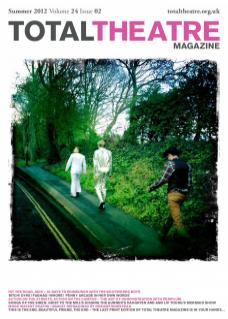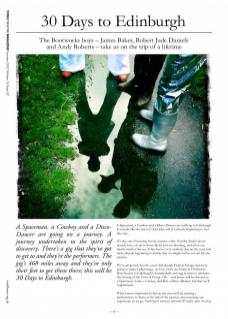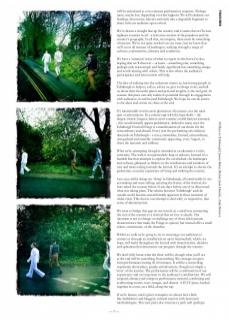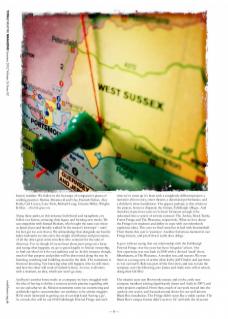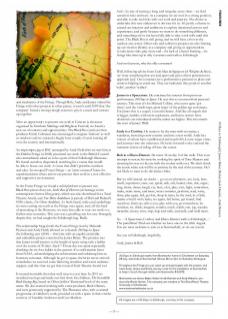A Spaceman, a Cowboy and a DiscoDancer are going on a journey. A journey undertaken in the spirit of discovery. There’s a gig that they’ve got to get to and they’re the performers. The gig’s 468 miles away and they’ve only their feet to get them there; this will be 30 Days to Edinburgh.
A Spaceman, a Cowboy and a Disco-Dancer are walking to Edinburgh. It sounds like the start of a bad joke and it’s already beginning to feel like one…
It’s day one of training for the journey; after 14 miles Andy’s shoes already have a hole in them, Rob’s feet are bleeding, and all of our hands smell of the sea. It has been a very ordinary day on the road and we’re already beginning to realise that we might not be cut out for the journey.
We’ve proposed, for this year’s Edinburgh Festival Fringe that we’re going to make a pilgrimage, on foot, from our home in Chichester, West Sussex to Edinburgh’s Summerhall, arriving in time to celebrate the closing of the Festival Fringe. Oh… and James will be dressed as a Spaceman, Andy a Cowboy, and Rob a Disco-Dancer; but that we’ll explain later.
What’s more important is that on the way we’ll be making a performance to share at the end of the journey, documenting our experience as we go. Each day’s journey (around 20 miles, give or take) will be articulated as a two-minute performative response. Perhaps more, maybe less, depending on what happens. We will condense our findings, discoveries, labours and trials into a digestible fragment to share with our audience upon arrival.
We’ve drawn a straight line up the country and it seems that we’ll cross eighteen counties in all – a fair cross-section of the populous and the country’s geography. In all that, we imagine, there must be something of interest. We’ve not quite worked out our route, but we know that we’ll cover all manner of landscapes, walking through a range of cultures, communities, climates and conditions.
We have a ‘common’ sense of what to expect in this but we’re also hoping that we’ll discover – or learn – something else; something perhaps only microscopic and barely significant but something unique and worth sharing with others. This is also where the audience’s participation and intervention will help.
The idea of walking into the unknown excites us, but having people in Edinburgh to help us, call us, advise us, give us things to do, and tell us about their favourite places and personal insights, is the real goal. In essence this piece can only realise its potential through its engagement with audiences, in and beyond Edinburgh. We hope we can do justice to the ideas and stories we share at the end.
It’s intentionally not the most glamorous of journeys, nor the most epic or adventurous. In a culture rapt with the hyperbolic – the largest, fattest, longest, fastest, most extreme, world-famous (etcetera) – this would initially appear problematic. Indeed in many ways the Edinburgh Festival Fringe is a manifestation of our desire for the extraordinary and absurd. Every year the performing arts industry descends on Edinburgh – a crazy, immediate, liminal, extraordinary, unregulated and anarchic community appearing, every August, to share the fantastic and sublime.
What we’re attempting though is intended as an alternative to this extremity. The walk is not particularly long or arduous. Instead it’s a humble feat that attempts to explore the overlooked, the landscapes and cultures glimpsed as flickers in the windscreens and windows of cars and trains racing towards the festival. It’s an attempt to elevate the pedestrian, everyday experience of living and walking the country.
Last year, whilst doing our ‘thing’ in Edinburgh, all comfortable in our art-making and ware-selling, enjoying the frenzy of the festival, the riots raked the country below. It was days before any of us discovered what was taking place. The schism between ‘Edinburgh’ and the outside world became uncomfortably apparent in these moments of wider crisis. This then is our attempt to deal with, or respond to, that sense of disconnection.
We want to bridge that gap on our travels, in a small way connecting the rest of the country to a festival that we love so dearly. Our intention is not to change or challenge any of those idiosyncratic characteristics that make the Fringe so special, but instead offer a small token, a mnemonic, of the elsewhere.
Whilst we walk we’re going to try to encourage our audiences to contact us through an installation set up in Summerhall, which, we hope, will build throughout the festival with shared stories, sketches and ephemera that documents our progress through the country.
We don’t fully know what the show will be, though what you’ll see at the end will be something from nothing. We envisage an openform performance lasting 45-60 minutes. It will be a storytelling experience about place, people and adventure, though not simply a ‘story’ of the journey. The performance will be a culmination of our experiences and our responses to the audience’s contributions. We will respond, abstract and compose performance material, combining and synthesising stories, texts, images, and objects. A D-I-Y piece, busked together in a tent, on a field, along the way.
If we’re honest, until a piece transpires we always feel a little like bullshitters and blaggers; cultural tourists with borrowed methodologies. This new piece also traverses a path well (perhaps better) trodden. We follow in the footsteps of comparative giants of walking practice: Marina Abramović and Ulay, Hamish Fulton, Alex Kelly, Carl Lavery, Lone Twin, Richard Long, Graeme Miller, Wrights & Sites… the list goes on.
Along these paths, in this instance both literal and metaphoric, we follow our heroes, retracing their legacy and forming new tracks. We can empathise with Samuel Beckett, who bought the same size shoes as James Joyce and literally walked ‘in the master’s footsteps’ – until his feet got too sore that is. We acknowledge that alongside our heavily laden rucksacks we also carry the weight of influence and provenance, of all the other great artist-travellers who ventured for the sake of discovery. For us though it’s never been about just trying out a form and seeing what happens; we go to great lengths to find an ownership, to find out what’s in it for our audience and us. In this instance though, much of that purpose and politic will be discovered along the way by listening, watching and fumbling around in the dark. The excitement is from not knowing. Not knowing what will happen, who we will meet, and how the show will work (if indeed it does). As ever, it all starts with a moment, an idea, which just won’t go away.
And here’s another home truth: as a company we have struggled with the idea of having to define a concrete artistic practice regarding who we are and what we do. Mission statements seem too constricting and artificially rigid to accommodate our tendency to be artistic magpies. We’re more interested in getting out of our depth and ‘having a go’. As a result, this will be our fifth Edinburgh Festival Fringe and each time we’ve come up it’s been with a completely different project: a narrative-driven story, street theatre, a durational performance, and a children’s show/installation. The appeal, perhaps, is that whatever the project, however disparate the format, Edinburgh obliges. And therefore in previous years we’ve been fortunate enough to be welcomed into a variety of artistic contexts: The Arches, Mock Turtle, Forest Fringe and The Pleasance, respectively. What we love about the Fringe is its madness and ability to cope with our relentlessly capricious ideas. This year we find ourselves in bed with Summerhall. Their theme this year is ‘journeys’. Another fortuitous moment in our Fringe history, and proof that it really does oblige.
It goes without saying that our relationship with the Edinburgh Festival Fringe over the years has been ‘irregular’ at best. Our first experience was way back in 2000 with a devised ‘mask’ show, Munchausen, at The Pleasance. A modest run, and success. We were there as a young crew of artists (then led by Joff Chafer) and just there to ‘cut our teeth’. Rob was part of this first crew, and was to take the company over the following year. James and Andy were still at school, doing their GCSEs!
The interim years saw Bootworks mutate and evolve, with new company members joining (significantly James and Andy in 2007) and other projects explored. From then, much of our work moved into the outdoor arts sector, and focused around shows for our well-known Black Box installation. The Fringe didn’t seem like a viable option. The Black Box’s unique format didn’t seem to ‘fit’ well with the structure and mechanics of the Fringe. Though Rob, Andy and James visited the Fringe with other projects in other guises, it wasn’t until 2009 that ‘the company’ found a strong enough reason to give it a crack and venture up together.
After an opportunity to present our work at Caravan (a showcase organised by Farnham Maltings and Brighton Festival) we found a new set of contacts and opportunities. The Black Box (and our then producer Emily Coleman) was encouraged to migrate ‘indoors’ as well as outdoors and we enjoyed a hugely busy couple of years touring all over the country and internationally.
An impromptu gig at BAC (arranged by Andy Field after we met him at the Dublin Fringe in 2008) presented our work to the British Council who immediately asked us to be a part of their Edinburgh Showcase. We found ourselves desperately searching for a venue that would be able to house our work. A venue that didn’t prioritise numbers and sales. In swooped Forest Fringe – an ‘artist-centered’ home for experimentation where artists can present their work in a cost-effective and supportive environment.
At the Forest Fringe we found a solid platform to present two Black Box pieces that year, Little Box of Horrors (an homage to the contemporary horror film genre), which was also shortlisted for a Total Theatre Award, and Une Boîte Andalouse (a parody of Dalí and Buñuel’s 1920s classic, Un Chien Andalou). As fresh-faced, wide-eyed underlings we were cutting our teeth at the Fringe once again, and, off the back of presenting at the Showcase, we were later able to tour our work to a further nine countries. This year was a gruelling one for sure. Strangely, despite this, we had caught the Edinburgh bug. Badly.
The relationship forged with the Forest Fringe (run by Deborah Pearson and Andy Field) allowed us to launch 30 Days to Space the following year (2010) – this time with an equally untenable and unfeasible project conceived by James Baker. The premise was that James would journey to the height of space using only a ladder over the course of 30 days. Each 7-8 hour day was spent repeatedly climbing the six-foot ladder in the pursuit of a confirmation letter from NASA, acknowledging the achievement and ordaining him an honorary astronaut. Although he got to space, the letter never arrived; nonetheless we received some flattering attention and warm audience support, and this time we got that coveted Total Theatre Award too!
It seemed inevitable then that we’d return a year later. In 2011 we stretched our legs and made our first show for children, The Incredible Book Eating Boy, based on Oliver Jeffers’ illustrated book of the same name. We also started working with a new producer, Becki Haines, and were generously supported by The Pleasance who, with a curated programme of children’s work, provided us with a space in their crèche courtesy of Candida Anderson and Cass Mathers.
And – by way of cutting a long, and irregular, story short – we find ourselves here and now. As a company we are now in a strong position, and able to take real risks with our work and practice. The choice to undertake this new endeavour is obvious for us. It’s partly a chance to extend our interests and ambitions to explore durational actions and experiences, and partly because we want to do something different, and something we’ve not been fully able to take a risk with until this point. The Black Box is still going, and we still have a foot in the outdoor arts sector. Other solo and collective projects are also firming up our creative identity as a company and giving us opportunities to take more risks, play more and – for lack of a better framing – do things like dress up in silly costumes and walk to Edinburgh.
And on that note, why the silly costumes?
Well, following advice from Crab Man & Signpost (of Wrights & Sites), we ‘wear something that sets [us] apart and gives others permission to approach [us]’. Our costumes are a performative presence in place and context: helping us stand out. They are indexical: they point to another ‘walk’, another ‘walker’.
James is a Spaceman. He continues his interest from previous performance 30 Days to Space. He sees this as an unresolved personal journey. This time it’s for Michael Collins, who never quite ‘got there’, and the ‘small steps, giant leaps’ of the golden age astronauts. For James this is a sequel, a second chance. And like all sequels this is bigger, badder, with more explosions, and better action. New characters are introduced and the stakes are higher. This also marks the start of James’ PhD.
Andy is a Cowboy. He wants to be the man-with-no-name; a wanderer, moseying cross-country and into a new world. Andy has visions of saloon bars, tumbleweed and stand-offs, Leone-esque vistas and journeys into the unknown. He looks forward to the end and the romantic notion of riding off into the sunset.
Rob is a Disco-Dancer. He turns 36 on day 2 of the walk. This is an attempt to rescue his mojo by evoking the spirit of Tony Manero and strutting his way to the city with the coolest walk ever. We don’t think the iconic white suit will be so pristine by the end of the journey. He’s not likely to want to do the dance either.
But we will instead, no doubt… go on an adventure, see, look, hear, smell, experience, taste, eat, speak, talk, tell, banter, chat, shit, argue, sing, shout, dance, laugh, cry, hurt, a lot, play, a lot, fight, sometimes, make, make more, and more, wear costumes, perform, read, write, draw, play again, fail, get lost, sleep in tents, by the road, in a field, maybe a bed if we’re lucky, try again, fail better, get found, find ourselves, find you, talk to you, play with you, go somewhere, be nowhere, sit, think, imagine, wonder, reach, climb, run, jog, wander, meander, mosey, strut, step, leap and walk, and walk, and walk more.
So… ‘A Spaceman, Cowboy and Disco-Dancer walk to Edinburgh…’ The punchline? Find out whether we have one on the 26th August. You are most welcome to join us at Summerhall, or on our travels.
See you in Edinburgh, hopefully,
Andy, James & Rob
30 Days to Edinburgh starts from Bootworks’ home in Chichester on Saturday 28 July, and ends at Summerhall (Venue 26) at 7pm on Saturday 26 August.
Throughout the Fringe you can catch up and participate with the project, and track Andy, James and Rob’s journey. Look for the installation at Summerhall, or keep in touch through twitter.com/bootworks #30DTE
Bootworks are James Baker, Robert Jude Daniels and Andy Roberts, produced by Becki Haines. The company are resident at The ShowRoom Theatre, University of Chichester. www.bootworkstheatre.co.uk
